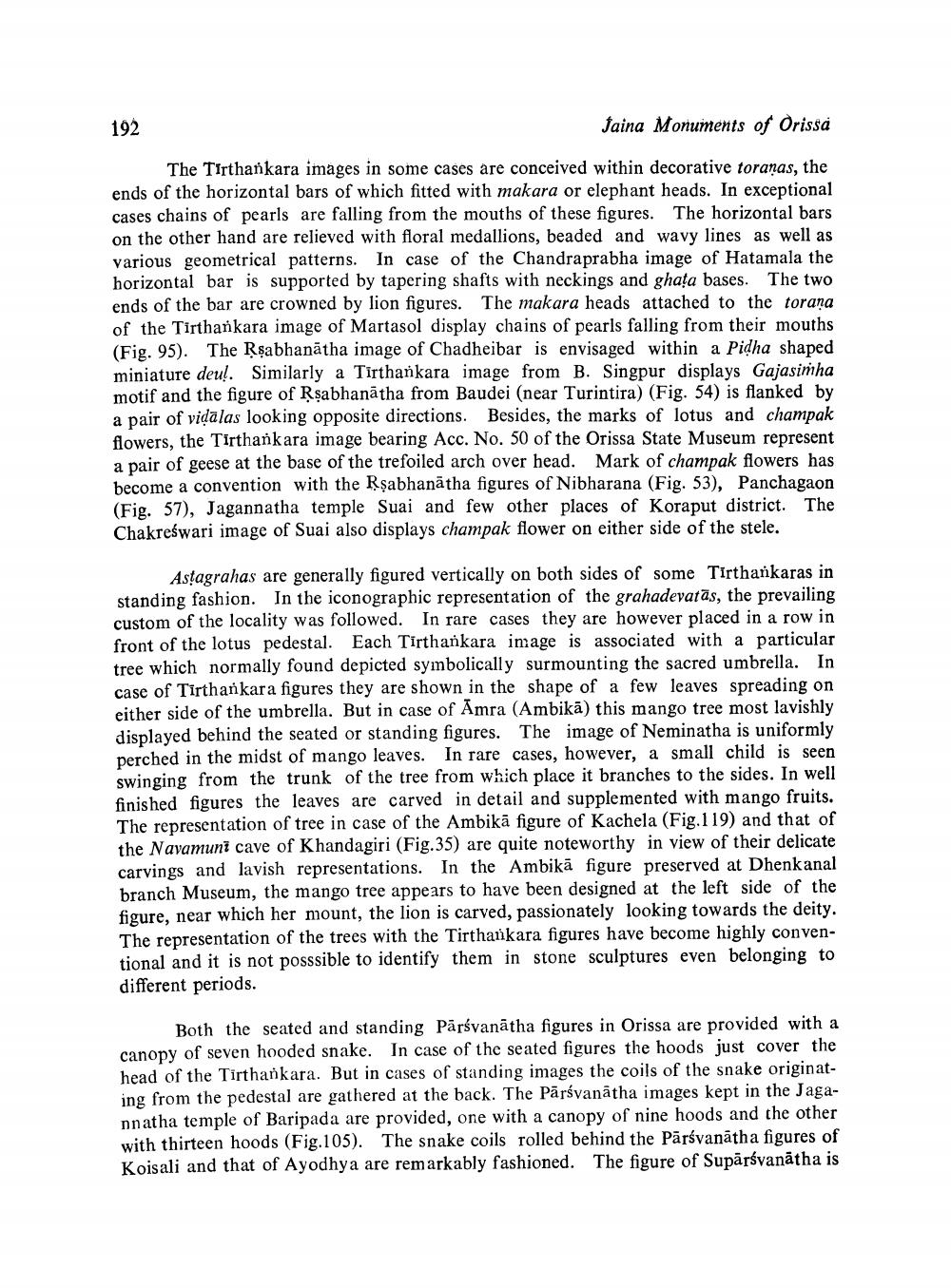________________
Jaina Monuments of Orissa
The Tirthankara images in some cases are conceived within decorative toranas, the ends of the horizontal bars of which fitted with makara or elephant heads. In exceptional cases chains of pearls are falling from the mouths of these figures. The horizontal bars on the other hand are relieved with floral medallions, beaded and wavy lines as well as various geometrical patterns. In case of the Chandraprabha image of Hatamala the horizontal bar is supported by tapering shafts with neckings and ghata bases. The two ends of the bar are crowned by lion figures. The makara heads attached to the toraṇa of the Tirthankara image of Martasol display chains of pearls falling from their mouths. (Fig. 95). The Reabhanatha image of Chadheibar is envisaged within a Picha shaped miniature deu!. Similarly a Tirthankara image from B. Singpur displays Gajasimha motif and the figure of Rṣabhanatha from Baudei (near Turintira) (Fig. 54) is flanked by a pair of vidalas looking opposite directions. Besides, the marks of lotus and champak flowers, the Tirthankara image bearing Acc. No. 50 of the Orissa State Museum represent a pair of geese at the base of the trefoiled arch over head. Mark of champak flowers has become a convention with the Rşabhanatha figures of Nibharana (Fig. 53), Panchagaon (Fig. 57), Jagannatha temple Suai and few other places of Koraput district. The Chakreswari image of Suai also displays champak flower on either side of the stele.
192
Astagrahas are generally figured vertically on both sides of some Tirthankaras in standing fashion. In the iconographic representation of the grahadevaras, the prevailing custom of the locality was followed. In rare cases they are however placed in a row in front of the lotus pedestal. Each Tirthankara image is associated with a particular tree which normally found depicted symbolically surmounting the sacred umbrella. In case of Tirthankara figures they are shown in the shape of a few leaves spreading on either side of the umbrella. But in case of Amra (Ambikā) this mango tree most lavishly displayed behind the seated or standing figures. The image of Neminatha is uniformly perched in the midst of mango leaves. In rare cases, however, a small child is seen swinging from the trunk of the tree from which place it branches to the sides. In well finished figures the leaves are carved in detail and supplemented with mango fruits. The representation of tree in case of the Ambika figure of Kachela (Fig.119) and that of the Navamunt cave of Khandagiri (Fig.35) are quite noteworthy in view of their delicate carvings and lavish representations. In the Ambikä figure preserved at Dhenkanal branch Museum, the mango tree appears to have been designed at the left side of the figure, near which her mount, the lion is carved, passionately looking towards the deity. The representation of the trees with the Tirthankara figures have become highly conventional and it is not posssible to identify them in stone sculptures even belonging to different periods.
Both the seated and standing Pärsvanatha figures in Orissa are provided with a canopy of seven hooded snake. In case of the seated figures the hoods just cover the head of the Tirthankara. But in cases of standing images the coils of the snake originating from the pedestal are gathered at the back. The Parsvanatha images kept in the Jagannatha temple of Baripada are provided, one with a canopy of nine hoods and the other with thirteen hoods (Fig.105). The snake coils rolled behind the Pärśvanätha figures of Koisali and that of Ayodhya are remarkably fashioned. The figure of Supårsvanatha is




